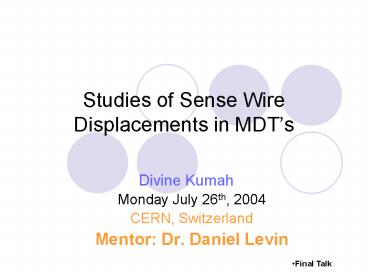Studies of Sense Wire Displacements in MDT - PowerPoint PPT Presentation
1 / 18
Title:
Studies of Sense Wire Displacements in MDT
Description:
Wire sag calculated for the different hodoscope positions Same angular ... 3080 V Operating Voltage 3.43 N Wire ... Muon Drift Tube Analysis Divine Kumah Author: – PowerPoint PPT presentation
Number of Views:134
Avg rating:3.0/5.0
Title: Studies of Sense Wire Displacements in MDT
1
Studies of Sense Wire Displacements in MDTs
Divine Kumah
- Monday July 26th, 2004
- CERN, Switzerland
- Mentor Dr. Daniel Levin
2
Outline
- Project Overview
- Scope of my project
- Results and Discussions
- Conclusion
- Questions
3
Atlas Setup(A Toroidal LHC Aparatus)
4
MDT Chamber Setup
- Each MDT consists of 2 multilayers separated by a
crossframe. - Each multilayer has 3 or 4 layers of cylindrical
gas filled aluminum tubes
- Tube diameter 30mm
- Gas Mixture
- Ar (93), CO2 (7)
- Tungsten sense wire (anode)
5
Drift Tube Operation
Measured relation between drift distance and
drift time for the ATLAS operating point.
4GeV Muon track produced from Garfield Simulation
6
MDT Operational Parameters
Parameter Value
Tube radius (rtube) 15.0 mm
Wire radius (rwire) 2.50 x 10-6 m
Wire density () 19.3 g/cm3
Wire Tension (T) 3.43 N
Operating Voltage 3080 V
Tube Length (L) 1.5 - 6 m
7
Motivation for Study
- Sense wire is displaced due to
- Gravity
- Electrostatic Forces
- Wire Displacement affects overall resolution of
the detector
Aims for Study
- Calculate the wire sag due to these forces
- Investigate the effect of sag on Drift Spectra by
- Analyzing Cosmic Ray Experiment Data
- Simulations in GARFIELD
8
Gravitational Sag
For Horizontal Tubes
- Chambers mounted in different orientations
- Sagging is minimal for vertically placed tubes
Maximum Gravitational Sag for MDT tubes up to 6m
Side View of the ATLAS Detector showing several
orientations of the Barrel MDT chambers
9
Electrostatic Amplification
- Electrostatic forces amplify Gravitational sag
Resultant sag from Fgravity and Felec
where
Tube Length (m) Max Gravitational Sag (mm) Electrostatic amplification Resultant Sagitta (mm)
1.5 30.3255 1.0021 30.389
6.0 485.208 1.0350 502.202
10
Experimental Setup
- Two 30 x 30 cm Hodoscopes
- 4 GeV Cosmic Ray muons, 3 hits/minute
- Pressure 3 bar
- Temperature 293 K
- Hodoscope Positions
- HV end
- 1.5 m from HV end
- Tube Center
11
Garfield Simulations
- Same gas mixture, temperature conditions as
actual experiment. - Wire sag calculated for the different hodoscope
positions - Same angular cosmic ray distribution as actual
experiment
www.garfield.com
12
Drift Time Spectra Fit
The rise is fitted with the Sigmoid function
T0 T0 where B t ie. Halfway up the rise
The falling edge is fitted with the function
Tend Tend where B t ie. Halfway up the fall
Maximum Drift TimeTmax Tend T0
13
Results for 1500 psi Gas Flow
Hodoscope Position Tube Middle 1.5m from HV end HV end
To (ns) 34.866 51.4302 66.882
Tend (ns) 768.104 774.344 740.44
Max Drift Time (ns) 733.237 722.914 673.56
D Tmax (ns) 59.672 49.349
14
Results for 2500 psi Gas Flow
Hodoscope Position Tube Middle 1.5m from HV end HV end
To (ns) 34.43 40.213 45.4668
Tend (ns) 752.358 682.751 716.682
Max Drift Time (ns) 717.928 642.538 671.215
D Tmax (ns) 46.713 41.803
- Garfield Simulation
- Maximum Drift Time for no-sag is 671 ns!
- Ashley has simulations in progress for displaced
wire positions.
www.garfield.com
15
Observations
Non-displaced wire
Displaced wire
- Increased Max Drift Time 50 ns
- Why?Increase in maximum drift path
- 2 Step tail
- Why?Wire Displacement
16
Conclusion
- Calculated Wire Sags in MDTs shows
gravitational wire sags 500 mm - Analysis of Cosmic Ray Experiment shows increase
in Drift times 50 ns due to wire sag - Comparison of Real Data with Garfield
simulations shows strong agreement. Garfield is
a reliable tool for further studies of wire sag
effects
17
Acknowledgements
- Dan Levin, Ed Diehl, Ashley Thrall
- Jean Krisch, Homer Neal, Jeremy Birnholtz
- The University of Michigan CERN-REU Program,
FORD, NSF, CERN - The UM-REU students, 2004 CERN Summies
18
QUESTIONS??































